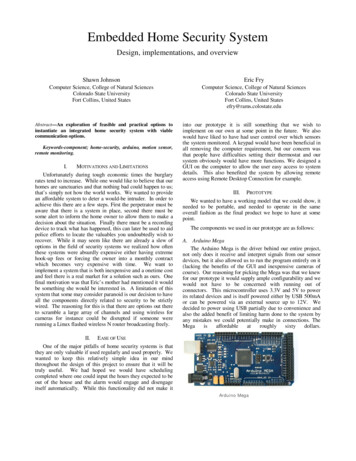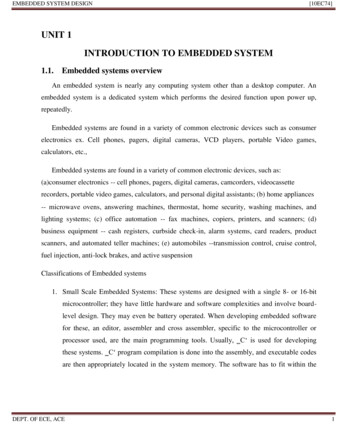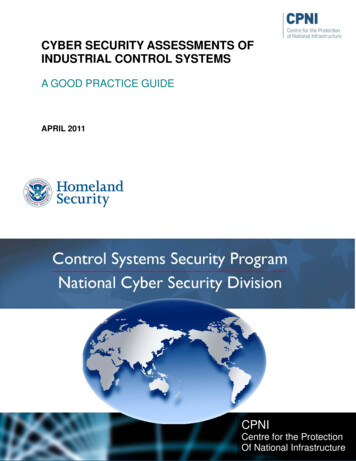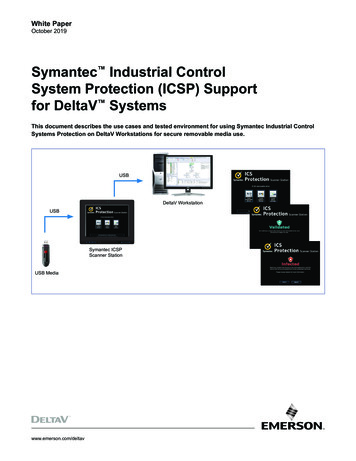
Transcription
EMBEDDED BASED INDUSTRIAL SECURITYSYSTEM WITH AUTO DIALERA project reportBACHELOR OF TECHNOLOGYInELECTRONICS & COMMUNICATION ENGINEERING
ABSTRACTEmbedded Industrial Security System withAuto-Dialer using 89C51 MicrocontrollerSecurity is primary concern for every one. This Project describes a design ofeffective security alarm system that can monitor an industry with eight different sensors.Unauthorized access, Fire accident, wall braking, IR detection, and fire detection can bemonitored by the status of each individual sensor and is indicated with an LED. ThisLED shows whether the sensor has been activated and whether the wiring to the sensor isin order. Obviously, this burglar alarm also has an input to 'arm' the alarm, a tamper inputand a couple of outputs to control a siren and Auto dialing system. The alarm is alsofitted with a so-called 'panic button'.The burglar alarm is built around the AT89C51 micro controller from Atmel. Thismicro controller provides all the functionality of the burglar alarm. It also takes care offiltering of the signals at the inputs. Only after an input has remained unchanged for 30milliseconds, is this new signal level passed on for processing by the micro controllerprogram. This time can be varied by adopting small changes in the source code.A maximum of 8 sensors can be connected to the burglar alarm. These sensorsneed to have their contacts closed when in the inactive state (i.e. Normally Closed). Inaddition, each sensor needs to have its tamper connection wired as well. A power supplyvoltage of 5 VDC is available for each sensor at the corresponding wiring terminals.Eight LEDs indicate the status of the corresponding sensors. When the alarm hasbeen activated, the LED of the sensor that caused the alarm will light up, or flash in theevent of a cable failure.
When the alarm is armed, the LED 'alarm armed' will flash during the exit-delay.After the exit-delay, the LED will light continuously. The LED 'alarm triggered LED'flashes during the entry-delay and will turn on continuously once an actual alarm hasbeen generated. 'Alarm triggered LED’ turns off only when the alarm is switched off withkey switch Sw1. When an alarm has taken place, it can be determined afterwards whichsensor (or tamper input) caused the alarm to trigger. The LED 'tamper' lights up when thetamper input is opened. This LED will also continue to be on until the alarm is switchedoff.The uniqueness of this project is not only alerting the neighbors by siren, it alsodials a mobile number which is already programmed into the system. A mobile numberor a land line number can be programmed into the system. As this system works onexisting telephone line, it can dial the number even the subscriber is out of station.This project uses regulated 5V, 500mA power supply. 7805 three terminal voltageregulator is used for voltage regulation. Bridge type full wave rectifier is used to rectifythe ac out put of secondary of 230/12V step down transformer.
CONTENTSCHAPTER 1:1.1 General introduction1.2 Organization of the projectCHAPTER 2:2.1 General theory2.2 Primary components2.2.1AT89C51 Micro controller2.2.2Sensor board2.2.3LED array2.2.4Driver circuit2.2.5ARM switch2.2.6PANIC switch2.2.7Reset circuit2.2.8ALARM2.2.9Relays2.2.10 Crystal oscillator2.2.11 Auto dialer2.2.12Power supply2.3 computer aided instruction2.3.1 Instruction DefinitionCHAPTER 3:3.1 General Block Diagram3.2 AT89C51 Microcontroller3.2.1 Features3.2.2 pin description3.2.3 Special function registers3.2.4 Memory organization3.3 Light-emitting diode (LED)3.4 Switches and Pushbuttons
CHAPTER 5:5.1 Parameters Used5.2 Theoretical ResultsCHAPTER 6:6.1Discussions6.2 Conclusion6.3 Future ScopeAPPENDIXLIST OF FIGURESFig 3.1 Block diagramFig 3.2 Block Diagram AT89C51 microcontrollerFig 3.3 Pin diagram of AT89C51 microcontrollerFig 3.4 A registerFig 3.5 B registerFig 3.6 Light emitting diode symbolFig 3.7 operation of LEDFig 3.8 operation of switchesFig 3.9 schematic of magnetic sensorFig 3.10 LDR symbolFig 3.11 operation of LDRFig 3.12 schematic of vibration detectorFig 3.13 ckt diagram of vibration detectorFig 3.14 ckt diagram of LM35Fig 3.15 schematic of panic switchFig 3.16 schematic of IR TxFig 3.17 smoke detector symbolFig 3.18 schematic of smoke detectorFig 3.19 complete schematic of auto dialerFig 3.20 block diagram of power supplyLIST OF TABLESTable 3.1 special function registersTable 3.2 R registers
CHAPTER 1This chapter consists of general introduction and organization of the project. In generalintroduction, the need of the project and literature survey of the project are discussed. Theorganization of the project deals with the description of the contents of different chapters in thethesis.1.1GENERAL INTRODUCTION:Aim of the design is to develop a prototype of developing a secured wireless data communicationsystem, which is being used for security application using an Embedded microcontroller both atthe transmitting and receiving sectionsThis project design makes use of 8051 microcontroller for interfacing to various hardwareinterfaces. Technology today is seeing its heights in all the areas, especially in the area ofEmbedded Systems. It is true that every electronic gadget that is used in daily life right from a PCkeyboard to a refrigerator is an Embedded System. This itself shows how vastly the technology isexpanding. This design is one of such application.The Micro controller which we are using in our Project is 8051 manufactured by ATMELCorporation. It is a 40 pin DIP plastic packaging CMOS technology having inbuilt ROM of 4K,RAM of 128 bytes, 32 I/O pins (of which two I/O pins P3.0 and P3.1 can be used for serialcommunication i.e., pins 10 & 11), 2 Timers and 6 Interrupts. It has an inbuilt Crystal Oscillatorgenerating 12 MHz connected to 18 & 19 pins which is indicated for speed of 8051. When theMicro Controller is at initial condition or got switched ON, the I/O pins are at high indicating asinput pins. The 40th pin is given Vcc supply of 5V and 20th to GND.Security is the condition of being protected against danger or loss. In the general sense, security isa concept similar to safety.The nuance between the two is an added emphasis on being protectedfrom dangers that originate from outside. Individuals or actions that encroach upon the conditionof protection are responsible for the breach of security. The word "security" in general usage issynonymous with "safety," but as a technical term "security" means that something not only issecure but that it has been secured. One of the best options for providing good security is by usinga technology named EMBEDDED SYSTEMS.when people become more and more attach importance ton the quality of life,the security and
service is important.Security has arguably become the prime mover of global politics today.it isthe basic common denominator for any successful societyany where in the world.Now a days thesecurity system can identify potential hazards to protect human.A typical intelligent securitysystem consists of intruders,fire,gas,environment sensors and more veriety sensors to be installed.Business and industry today requires security systems that are the fact of life.Your companysimply must have them to protect your employees,your equioment and the very buildingsthemselves.There is only one thing more important than the selection of the security systems toprotect your facilities.That is why you should consider reliable fire equipment for your securitysystem requirements.security and fire protection are closely related to energy management in so far as they presenttractable goals for automated systems.It has been considered relatively easy for machine basedsystems to recognize anomalous activity around the home which could be interpreted as possiblesecurity breaches,accidents or fires.Damage done to humans by vandalism,pollution or pests canusually be repaired.Fire damage,however can be permanent and involves the entire life ofhuman.Much can be done to minimize the chance of a fire stating or spreading.Progress in fire technologies has been substantial over last decade due to advances insensor,microelectronics and information technologies,as well as a greater understanding of firephysics.This paper provides a review of progress in fire detection technologies over the lastdecades some problems & a future research efforts related to current fire detection technologiesare discussed.Generally in any industry,there are several blocks and there is an administrative block whichcontrols all blocks.If any problem is created in any one of the blocks,at first the persons in thatparticular block has to inform to the administrative block and then the action will be taken.So if we consider a fire accident in any one of the blocks the person on that incident generally theymakes a call to the administrative block or security block as took over and they has to call theambulance,fire station etc.it will be a long process,so in the mean the damage may increase in hugeextent.The most basic fire protection methods include fire prevention,detection and control.Buildingsshould be constructed using fire rated walls,doors,ceilings and floors.The use of combustible
materials in interior furnishing should be kept to a minimum.there are several types of detectiondevices.Automatic fire detection systems,when combined with other elements of an emergency responseand evacuation plan,can significantly reduce property damage,personal injuries,and loss of lifefrom fire in the work place.Their main function is to quickly identify a developing fire and alertbuilding occupants and emergency response personnel before extensive damage occurs.Automaticfire detection systems do this by using electronic sensors to detect the smoke,heat or flames andproviding an early warning.Flame detectors which respond to the flame stage of the fire:heat detectors which respond to heatgenerated in the flame stage of a fire and smoke detectors which respond to the particles ofcumbersion produced in a fire.A fire alarm control panel,normally referred to as a panel within the active fire protection industryis cental control device for detecting,reporting and actiong on occurances of fire with in abuilding.there are two types of panel's fallen conventional panels and analogue addressablepanels.In a conventional panel,fire detection devices including,but not limited to smokedetectors,heat detectors and manual call points are joined up with a number connected to thecircuit.When a device on the circuit is activated the panel recognizes an alarm on that circuit andcould be setup to take a number of actions including directly calling the fire department via analarm transportation system.An addressable panel ia a more modern type of panel and has a greater flexibility than aconventional panel.An addressable panel has a number of loops where anumber of devices are tobe connected,each with its own address.The lessons of continuing false alarms should not go unnoticed and will serve as a remindertothose who wish to address other areas of automation that even the most well defined,well boundedareas of activity must admit flexibility.Bad experiences with early systems have left the policereluctant to allow domestic security system to call for assistance directly,except on high risksituations.security systems can noe be configured to call several telephones in the event of analarm so that the occupants are nominated care takers can be alerted before caling the police.Monitoring of the security system ensures an effective response to an electronic activation or in
times of personal duress.The response opions are customized to suitthe individual risk securityrequirements in cost effective manner.Monitoring is done through a telephone line and dependngon the security task it will involve a basic digital dialer or a security interface.The most commonmethod of monitoring is achieved via the basic dialer.This is for low to medium security risk and isconnected to the existing telephoneline through a special socket.The system will communicatewhen an alarm condition needs to be reported or when a call is made to test the system.This test ismade as often as required to ensure more or less security.the security interface provides the sameservice but it involves a scanning of the existing telephone line by the telephone company toensure greater security.should the telephone line be damaged accidentally or on purpose themonitoring station will detect the alarm condition with in seconds.Now a days trend in network communication leads to replacing the cables, providing mobility andfreedom of movement for the user’s. The utilization of wireless techniques has spread its scope onto different application fields. one of such spheres is industry. With the addition of wirelessconnectivity to most embedded designs, zones of security will be needed around each criticalsystem MCU, in addition to the one traditionally surrounding the gateway to the broader network.(Source: Atmel)."Beyond the huge cost savings incurred by eliminating wires, are the continuingcosts in maintenance that will be eliminated, as well as the flexibility that gives the manufacturerwho wants to recognize the factory floor, add new systems and eliminate others. No wires toconnect and disconnect eliminates a lot of costs and will make the factory floor a much moredynamic environment".This Project describes a design of effective security alarm system that can monitor anindustry with eight different sensors. Unauthorized access, Fire accident, wall braking, IRdetection, and fire detection can be monitored by the status of each individual sensor and isindicated with an LED. This LED shows whether the sensor has been activated and whether thewiring to the sensor is in order. Obviously, this burglar alarm also has an input to 'arm' the alarm, atamper input and a couple of outputs to control a siren and Auto dialing system. The alarm is alsofitted with a so-called 'panic button'.The burglar alarm is built around the AT89C51 micro controller from Atmel. This microcontroller provides all the functionality of the burglar alarm. It also takes care of filtering of thesignals at the inputs. Only after an input has remained unchanged for 30 milliseconds, is this newsignal level passed on for processing by the micro controller program. This time can be varied byadopting small changes in the source code.
A maximum of 8 sensors can be connected to the burglar alarm. These sensors need to havetheir contacts closed when in the inactive state (i.e. Normally Closed). In addition, each sensorneeds to have its tamper connection wired as well. A power supply voltage of 5 VDC is availablefor each sensor at the corresponding wiring terminals.Eight LEDs indicate the status of the corresponding sensors. When the alarm has beenactivated, the LED of the sensor that caused the alarm will light up, or flash in the event of a cablefailure.When the alarm is armed, the LED 'alarm armed' will flash during the exit-delay. After theexit-delay, the LED will light continuously. The LED 'alarm triggered LED' flashes during theentry-delay and will turn on continuously once an actual alarm has been generated. 'Alarmtriggered LED’ turns off only when the alarm is switched off with key switch Sw1. When an alarmhas taken place, it can be determined afterwards which sensor (or tamper input) caused the alarm totrigger. The LED 'tamper' lights up when the tamper input is opened. This LED will also continueto be on until the alarm is switched off.The uniqueness of this project is not only alerting the neighbors by siren, it also dials amobile number which is already programmed into the system. A mobile number or a land linenumber can be programmed into the system. As this system works on existing telephone line, itcan dial the number even the subscriber is out of station.This project uses regulated 5V, 500mA power supply. 7805 three terminal voltage regulator isused for voltage regulation. Bridge type full wave rectifier is used to rectify the ac out put ofsecondary of 230/12V step down transformer.As the operation of microcontroller-based system is inherently based on the stored programconcept, the software plays a very crucial role. The relationship between the hardware andsoftware is similar to the relation between body and soul. One has an meaningful existence withoutthe other. The hardware is the body, which is used as the medium of software. In order to developthe software for microcontroller based system, one must acquire knowledge about the set ofinstructions which are used as a building blocks in writing a program and learn the art of programthat is the tools and techniques of putting instructions together in a logic manner to form a programimplementing the desired operations. The Keil 8051 development tools are designed to solve thecomplex problems facing embedded software developed.
CHAPTER 2This chapter deals with the general introduction of all the components used in this thesis. So wecan have a general idea about all the components. Also some computer aidedinstructions andtheir operation is also discussed in this chapter. As these instructions are assembly languageinstructions, these are useful to acquire more knowledge about the embedded system code.2.1 GENERAL THEORY:An embedded system can be defined as a computing device that does a specific focused job.Appliances such as the air-conditioner, VCD player, DVD player, printer, fax machine, mobilephone etc. are examples of embedded systems. Each of these appliances will have a processor andspecial hardware to meet the specific requirement of the application along with the embeddedsoftware that is executed by the processor for meeting that specific requirement. The embeddedsoftware is also called “firm ware”. The desktop/laptop computer is a general purpose computer.You can use it for a variety of applications such as playing games, word processing, accounting,software development and so on. In contrast, the software in the embedded systems is always fixedlisted below:1 Embedded systems do a very specific task; they cannot be programmed to do differentthings. . Embedded systems have very limited resources, particularly the memory.Generally, they do not have secondary storage devices such as the CDROM or the floppydisk. Embedded systems have to work against some deadlines. A specific job has to becompleted within a specific time. In some embedded systems, called real-time systems, the
deadlines are stringent. Missing a deadline may cause a catastrophe-loss of life or damageto property. Embedded systems are constrained for power. As many embedded systemsoperate through a battery, the power consumption has to be very low.2.2 PRIMARY COMPONENTS:2.2.1 AT89C51 Micro controller2.2.2 Sensor board2.2.3 LED array2.2.4 Driver circuit2.2.5 ARM switch2.2.6 PANIC switch2.2.7 Reset circuit2.2.8 ALARM2.2.9 Relays2.2.10 Crystal oscillator2.2.11 Auto dialer2.2.12 Power supply2.2.1 AT89C51 Micro controller:8051 is one of the most popular micro controllers in use today. Many derivative micro controllerhave since been developed that are based on and compatible with the 8051.Thus, the ability toprogram an 8051 is an important skill for any one who plans to develop products that will takeadvantage of micro controller. P89C51 is same as the INTEL 8051 except that 89C51 has internalflash ROM, which can be programmed more than 1000 times.The AT89C51 is a low power, high-performance CMOS 8-bit micro controller with 8K bytes of insystem programmable flash memory. The P89C51 is designed with static logic for operation downto zero frequency and supports two software selectable power saving modes. The 89C51 microcontroller unit is a fast, single chip micro controller family.2.2.2 Sensor Board:The different sensors used in this project are as follows:1. REED SWITCHES or MAGNETIC SENSORS2. LED & LDR section pag
Embedded Industrial Security System with Auto-Dialer using 89C51 Microcontroller Security is primary concern for every one. This Project describes a design of effective security alarm system that can monitor an industry with eight different sensors. Unauthorized access, Fire accide











